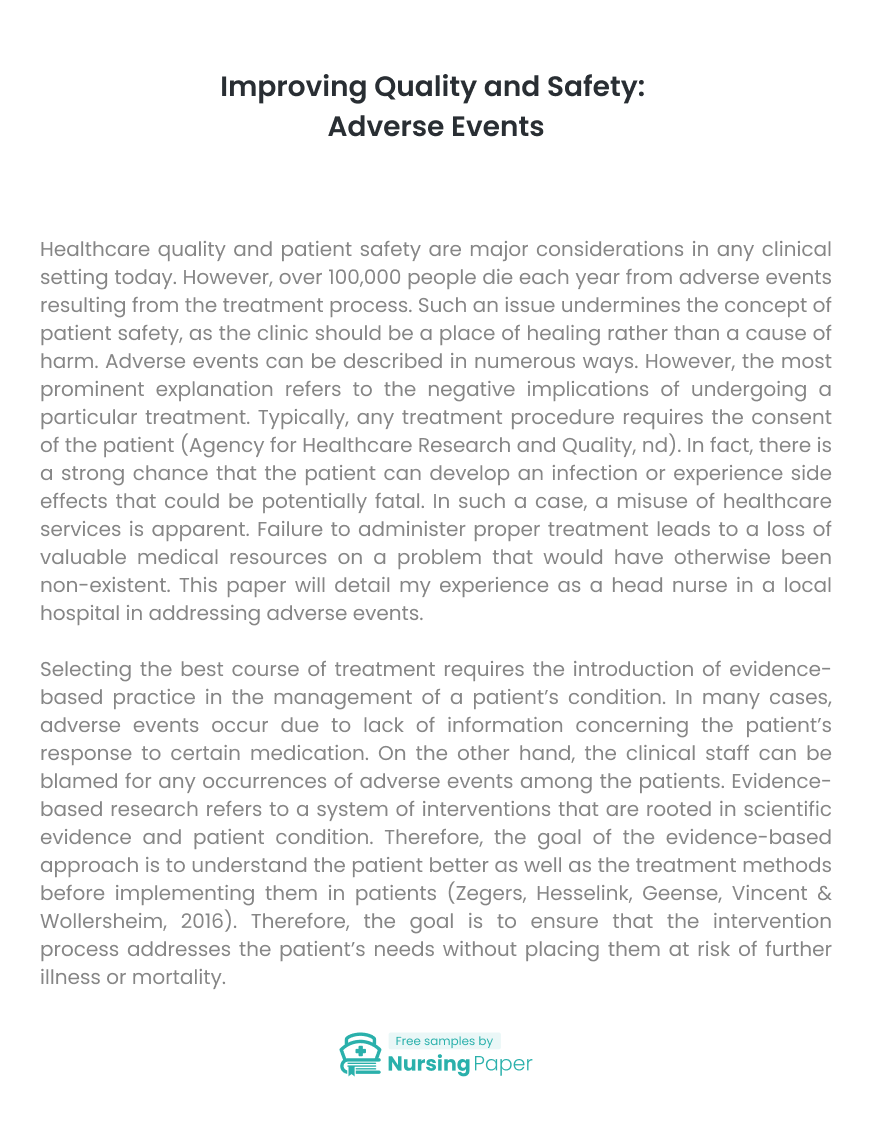
Improving Quality and Safety: Adverse Events
Introduction
Healthcare quality and patient safety are major considerations in any clinical setting today. However, over 100,000 people die each year from adverse events resulting from the treatment process. Such an issue undermines the concept of patient safety, as the clinic should be a place of healing rather than a cause of harm. Adverse events can be described in numerous ways. However, the most prominent explanation refers to the negative implications of undergoing a particular treatment. Typically, any treatment procedure requires the consent of the patient (Agency for Healthcare Research and Quality, nd). In fact, there is a strong chance that the patient can develop an infection or experience side effects that could be potentially fatal. In such a case, a misuse of healthcare services is apparent. Failure to administer proper treatment leads to a loss of valuable medical resources on a problem that would have otherwise been non-existent. This paper will detail my experience as a head nurse in a local hospital in addressing adverse events.
Selecting the best course of treatment requires the introduction of evidence-based practice in the management of a patient’s condition. In many cases, adverse events occur due to lack of information concerning the patient’s response to certain medication. On the other hand, the clinical staff can be blamed for any occurrences of adverse events among the patients. Evidence-based research refers to a system of interventions that are rooted in scientific evidence and patient condition. Therefore, the goal of the evidence-based approach is to understand the patient better as well as the treatment methods before implementing them in patients (Zegers, Hesselink, Geense, Vincent & Wollersheim, 2016). Therefore, the goal is to ensure that the intervention process addresses the patient’s needs without placing them at risk of further illness or mortality. Using interventions that have been proven and tailoring them to meet the unique qualities of the patient remains the key strategy towards managing adverse events in healthcare.


This solution addresses at least three of the six aims for improvement. Firstly, it addresses the dimension of safety prominently (Agency for Healthcare Research and Quality, 2016). Patient safety should always remain at the forefront of any treatment process. The healthcare professionals undertake the responsibility of addressing the safety of a patient. More so, these medical practitioners have the responsibility of helping the patients rather than undermining their compromised health. It also addresses the aim of patient-centered care. This concept refers to administering treatment that addresses a patient’s preferences, conditions, and values (Rathert, Wyrwich & Boren, 2013). The key is to ensure that every procedure done on the patient relies on information particular to the individual. Finally, the strategy also addresses the goal of efficiency. As established before, adverse events constitute a misuse of services. Adverse effects lead to additional investment of resources into a case that would have otherwise been non-existent. As such, using resources to treat the side effects of treatment is a waste of valuable organizational capital.
Inter-professional collaboration refers to the interaction of medical practitioners and other experts across numerous disciplines. The goal of such collaborative effort is to increase the number of perspectives available to key decision-makers in the healthcare industry. The presence of an interdisciplinary team empowers the practitioners to provide comprehensive care using a broad description of skills (Martin, Ummenhofer, Manser & Spirig, 2010). Furthermore, the presence of a team ensures that the patient receives the best possible care. The superiority in acre arises from having a team that responds to all the patient’s needs as per the patient-centered model of care. Overall, evidence-based care revolves around using the information to increase patient safety, especially concerning adverse events.
1. Agency for Healthcare Research and Quality. (2016). The Six Domains of Health Care Quality | Agency for Healthcare Research & Quality. Retrieved from https://www.ahrq.gov/professionals/quality-patient-safety/talkingquality/create/sixdomains.html
2. Agency for Healthcare Research and Quality. (nd). Improving Health Care Quality | AHRQ Archive. Retrieved from https://archive.ahrq.gov/research/findings/factsheets/errors-safety/improving-quality/improving-health-care-quality.html
3. Martin, J. S., Ummenhofer, W., Manser, T., & Spirig, R. (2010). Interprofessional collaboration among nurses and physicians: making a difference in patient outcome. Swiss Med Wkly, 140, w13062.
4. Rathert, C., Wyrwich, M. D., & Boren, S. A. (2013). Patient-centered care and outcomes: a systematic review of the literature. Medical Care Research and Review, 70(4), 351-379.
5. Zegers, M., Hesselink, G., Geense, W., Vincent, C., & Wollersheim, H. (2016). Evidence-based interventions to reduce adverse events in hospitals: a systematic review of systematic reviews. BMJ Open, 6(9), e012555.



The download will start shortly.

The download will start shortly.
 Subject:
Health and Social Care
Subject:
Health and Social Care  Number of pages: 12
Number of pages: 12  Subject:
Nursing
Subject:
Nursing  Number of pages: 8
Number of pages: 8  Subject:
Health and Social Care
Subject:
Health and Social Care  Number of pages: 10
Number of pages: 10  Subject:
Medicine
Subject:
Medicine  Number of pages: 5
Number of pages: 5  Subject:
Medicine
Subject:
Medicine  Number of pages: 2
Number of pages: 2  Subject:
Nursing
Subject:
Nursing  Number of pages: 5
Number of pages: 5  Subject:
Nursing
Subject:
Nursing  Number of pages: 2
Number of pages: 2  Subject:
Medicine
Subject:
Medicine  Number of pages: 2
Number of pages: 2  Subject:
Medicine
Subject:
Medicine  Number of pages: 4
Number of pages: 4  Subject:
Medicine
Subject:
Medicine  Number of pages: 3
Number of pages: 3  Subject:
Health and Social Care
Subject:
Health and Social Care  Number of pages: 5
Number of pages: 5  Subject:
Nursing
Subject:
Nursing  Number of pages: 2
Number of pages: 2  Subject:
Health and Social Care
Subject:
Health and Social Care  Number of pages: 3
Number of pages: 3  Subject:
Nursing
Subject:
Nursing  Number of pages: 11
Number of pages: 11  Subject:
Health and Social Care
Subject:
Health and Social Care  Number of pages: 8
Number of pages: 8 
